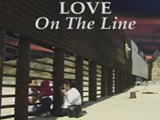
It's a typically hot Sunday afternoon on the border between southern California and northern Mexico. In Tijuana, Magdalena Hernandez puts a few tortas made of ham and cheese, wrapped in plastic, in her purple backpack. Leaving San Diego, Jose Hernandez rides the Mexicoach trolley heading south, a white towel tucked under his arm. Our camera silently follows them both as they prepare to spend this Sunday afternoon, like many others, at the beach.
When Jose arrives at Border State Park, the scene is at first typical. Our frame is filled by the edge of a small parking lot, picnic tables, and sun shimmering off the edge of the Pacific Ocean in the distance. As the shot widens however, the scene becomes unique, surreal.To Jose's left looms a white Range Rover marked "Border Patrol," to his right is a 15 foot tall, rusting steel fence—the Border that separates the United States and Mexico. The only land border between the First and Third Worlds.
As Jose makes his way down the bluff, heading towards the water, the steel wall which extends 150 feet into the ocean changes from being made of steel plates to being made of steel bars. This allows the waves, during high tide, to come crashing through the wall. As he arrives at this section of the fence, his face comes to life, he cracks a smile.He hustles up to the fence, greets his wife Magdalena who's been waiting on the other side, and gives her a small kiss on the lips. The couple spends the afternoon together, eating tortas, and chatting about the past week, after a few minutes forgetting that this picnic is happening through the bars of the steel border.
Since January 1st, 1999, Magdalena Hernandez, who lives in Tijuana, has been meeting with her husband, who lives in San Diego, every Sunday at the beach where the western border between the United States and Mexico ends. Her husband is legally in the U.S., with a green card, but is petitioning for a change in status. In a few years he should be a citizen. During the wave of "immigration reform" laws passed in the late 90's, a law was changed, basically not allowing legal immigrants who are petitioning for a change of status to leave the confines of the U.S. If they do, their petition starts again upon re-entry. These petitions usually take about 3 years to be processed.
To try to deal with this situation, more than a few Pan-American couples on the San Diego/Tijuana border have taken to meeting at the beach, on Sunday afternoons, to talk, eat, and kiss through the steel bars of the international border.
Love on the Line will be an hour long documentary, made up of three chapters, each focused on a different cross-border couple.
Each portrait will begin at the border beach—this is the thread that unites the stories. Beyond that location each story becomes distinct, as we learn more about the daily lives, and history, of each family. We will try to select the families in a way that represents the various reasons that motivate millions of Mexicans to attempt to emigrate each year. As each couple urgently tries to untangle the legal webs that separate them, the question that drives each narrative will be "Do they reunite?"
|




